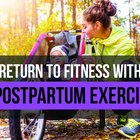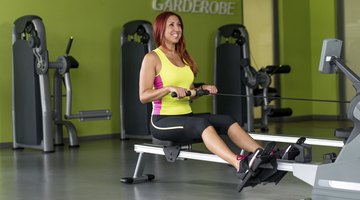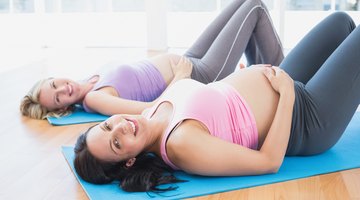Best Exercises by Trimester
Taking care of your body through routine exercise is one of the most important goals you can set during a pregnancy. "While some might think pregnancy is the time to take it easy on the couch, in reality it is the opposite," says Leslie McNabb, a restorative exercise specialist and Pilates instructor in New York City. "These nine months should be about getting healthy and acquiring what your body needs for an easy delivery, a fast recovery and the physical demands of caring for a newborn." In addition to eating a healthy diet and aiming for sufficient nightly sleep, the following exercises can help keep you and your baby healthy throughout pregnancy and beyond. After you've perused the slides, join our discussion by posting a comment below.
Trimester One: Calf and Hamstring Stretch
Weight gain and circulation changes during pregnancy can trigger cramps and spasms in your legs. While these symptoms are more common during later pregnancy, according to the American Pregnancy Association, forming the habit of stretching your calf and hamstring muscles early on can help prevent them altogether. "Take a rolled up towel and place the balls of your feet on the towel while your heels remain on the floor," said Leslie McNabb, a restorative exercise specialist and Pilates instructor in New York City. "Keeping the spine straight, tip over from the hip until you feel a slight stretch in your calves and hamstrings." She recommends starting as soon as you learn you're pregnant and gradually working your way up to one-minute holds, preferably three times per day.
Related: Leg Cramps During Pregnancy
Trimester One: Jumping Side Lunges

Exercises for SPD After Birth
Learn More
"It’s important to incorporate strength, cardio and flexibility during the entire pregnancy," said Amie Hoff, a certified personal trainer in New York City. Jumping side lunges address all three. You essentially lunge one leg to the side while bending the other, jump, then land in the original position, only reversed. Start by stepping out to the side with one leg, toe pointed straight, and bending your opposite knee. Then jump up, pushing off the bent leg to land in the same position on the other side. "Start with small jumps and land with knees soft, not straight," Hoff added. Repeating the motion will get your heart rate up and soon you'll break a sweat. You'll also strengthen and stretch your leg muscles. Do a few sets to start with, taking breaks to catch your breath in between.
Trimester One: Power Squats
Squats help strengthen your core while enhancing flexibility and balance. They also help prepare your body for childbirth, said Leslie McNabb, a restorative exercise specialist and Pilates instructor in New York City. "As soon as you discover you are pregnant, practice your squat daily so you have time to build strength," she said. A proper squat begins with your feet at shoulders-width apart and your toes facing forward. Keeping your back straight, lower your torso as though you're sitting down on a chair. Your shins should remain vertical, said McNabb, and your knees should stay aligned over your ankles. You should also have a slight arch in your lower back and avoid thrusting your ribs forward. "Go as low as you can while maintaining the proper form," she added. "Work on getting lower and holding the position." For extra support, sit on a low stool or against a wall or tree.
Related: Strengthening Your Core: Right and Wrong Ways to Do Lunges, Squats and Planks
Trimester One: Walk Your Way Fit

Return to Fitness With These 10 Postpartum Exercises
Learn More
Walking is the most popular exercise for pregnant women, according to FitPregnancy.com. It's low impact, doable most anywhere and works your cardiovascular system while strengthening most of your major muscles, particularly in your legs. While you can likely walk throughout your pregnancy, the energizing activity could be particularly helpful during the first trimester, when lethargy typically peaks. Wear comfortable shoes and walk on smooth surfaces when possible, avoiding particularly hilly or bumpy terrain. If you walk outdoors, you'll reap the added benefits of fresh air and vitamin D -- a nutrient particularly important during pregnancy.
Related: Walk This Way
Trimester Two: Mountain Climbers
The second trimester of pregnancy often brings a renewed sense of vitality, as the morning sickness and increased exhaustion of the first trimester are behind you. To take advantage of this and continue to increase leg strength and balance, Amie Hoff, a certified personal trainer in New York City, recommends mountain climbers. Begin in a raised push-up position, with your hands on the ground just below your shoulders and your back straight. Keeping your elbows soft, draw one knee up toward your armpit, then thrust it back to its original position. As you do so, draw your other leg upward. You'll essentially jump from one leg-tucked position to the other in a continual motion. Hoff suggests keeping your abs tight, which provides toning benefits similar to those gained by doing crunches. Mountain climbers will also send your pulse climbing, so even modest amounts provide mega cardio perks.
Trimester Two: Tricep Kickbacks
Strengthening your triceps, the underside muscles of your upper arms, helps ensure that you'll be able to lift and carry your little one with ease. The added muscle also increases your metabolism, making it easier to shed post-pregancy pounds. Amie Hoff, a certified personal trainer in New York City, recommends tricep kickbacks during the second trimester. Anchor a rubber exercise tube at chest level by looping it around a pole, railing or tree. Stand with one foot in front of the other, one hand clutching the tube handle -- palm facedown -- and the other hand braced on your opposite, slightly bent knee. Lean forward with your elbows at your sides. Straighten the tube-holding arm, pulling the tube away from the anchor. Then unstraighten your arm, releasing the tension. Continue pulling and releasing for five to 10 minutes at a time.
Trimester Two: Marching With Weights
For a great cardio workout that also strengthens your arms, Joel Harper, an athletic trainer and guest fitness expert on the Dr. Oz Show, recommends marching with arm weights as part of his 30-minute second trimester workout. Simply stand with your feet slightly wider than the width of your shoulders, holding one small arm weight (such as a 3-pound weight) in each hand. Begin marching, lifting your knees. Once you've warmed up, lift your knees slightly higher for greater toning and cardiovascular benefits. "You want to float your feet off the mat," he said. Your feet should barely make any noise. You can march barefoot on an exercise mat or thick carpet. Wear supportive workout shoes if you opt to march outdoors.
Trimester Two: Incline Push-up
Push-ups aren't often easy for women. With the increased belly size and weight that accompanies pregnancy, they're even tougher. The solution? Do push-ups at an incline rather than flat on the floor. Placing your hands on a box, step or bench reduces the amount of body weight you have to lift. Once in the push-up position, lower your body until it forms a straight line from the floor to the object on which your hands are placed. Pause briefly before pushing yourself back up. Your body should stay rigid, says Adam Campbell, an Oprah.com fitness expert and author of "The Women's Health Big Book of Exercises." He adds that the steeper the incline, the easier the push-ups.. If they seem too easy -- and your belly allows it -- lower the incline. Campbell suggests doing 12 to 15 repetitions at a time.
Trimester Three: Butterfly Stretch
Stretching continues to be important in your final trimester, but doing so on your back could disrupt circulation, according to Leslie McNabb, a restorative exercise specialist and Pilates instructor in New York City. "Instead of lying on your back, try sitting on a yoga block," she suggested. "Bend your knees to bring soles of feet together." This stretch, known as the butterfly stretch, increases flexibility throughout the lower body, which plays an important role in delivery. It also helps loosen your inner thigh muscles, making it a helpful choice after leg-intensive activities, such as walking and squats. To focus on one leg at a time and stretch your back, extend one leg outward, turn your torso to the opposite side and press the opposite hand on your tucked-in knee (as pictured).
Trimester Three: Power Walking
Power walking is particularly useful during your third trimester, says Amie Hoff, a certified personal trainer in New York City. If you've been jogging or running, lowering the impact of your workouts during later months can help prevent joint pain as your weight increases. Staying as active as you can allows gravity to help the final stages of pregnancy progress. To power walk appropriately, stand tall and keep your eyes focused about 20 feet ahead of you. Keep your shoulders relaxed, your arms bent at an angle of slightly less than 90 degrees, and your hands gently cupped. Swing your arms to and fro (not side to side) and walk at a brisk pace, aiming for small, quick steps rather than long strides. Most power walkers maintain a pace of 12 to 15 minutes per mile.
Related: Tips for Walking Faster
Third Trimester: The Penguin
To work your leg and hip muscles during your last trimester, Amie Hoff, a certified personal trainer in New York City, recommends an exercise known as the penguin. It allows you to stay upright and strengthen muscles surrounding the birth canal. Place a rubber workout tube on the floor beneath both of your feet, which should be shoulder-width apart. Grasping one handle in each hand, lift one leg out to the side as you keep the other leg straight. Then bring your leg back in and repeat. Do 10 to 15 repetitions with one leg, then switch to the other. "Try to maintain balance," added Hoff. "Bring your feet closer to make it easier." If it seems too easy, widen your step until you feel challenged.
Third Trimester: Stationary Cycling
Exercising on your feet can grow increasingly difficult throughout pregnancy, and ankle and foot swelling is common. Peddling a stationary bike allows you to engage in moderately intense cardio while seated, and may help reduce bodily swelling by increasing circulation. The biggest benefit of biking is that the bike supports your weight, says the American Pregnancy Association, so there is less stress on your body. As you belly grows, it puts a great deal of stress on your back. Start biking slowly, the association suggests, and don't overdo it. You can also bike in intervals, moving at a moderately intense speed for several minutes, then reducing your pace until your heart rate lowers. Then repeat the process several times before cooling down.
Related: American Pregnancy Association: Exercise and Pregnancy
What Do You Think?
Which exercise idea most interests you? Any questions or tips to add? How have you stayed fit during pregnancy? Post your comments below. And remember, all pregnancy-related fitness activities should be approved by your doctor, particularly in the case of a high-risk pregnancy. Once your workout is approved, do your best to make it enjoyable. A happy mom is just as important as a healthy one.
Related Articles
- Leslie McNabb; restorative exercise specialist and Pilates instructor; New York City
- Amie Hoff; certified personal trainer; New York City
- CardioMD: First Trimester Fatigue
- CNN.com: Study: Pregnant Women Should Get More Vitamin D
- The Walking Site: Tips for Walking Faster










